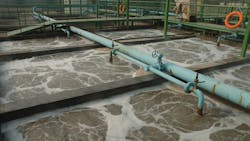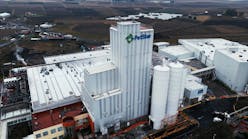Industrial wastewater is increasingly under the regulatory microscope. The U.S. Environmental Protection Agency has for the first-time proposed setting limits on the disposal of wastewater into the environment containing a family of chemicals known as PFAS.
The agency’s focus on perfluoroalkyl and polyfluoroalkyl compounds can be expected to have wide-ranging effects across industries. They are ubiquitous, found in numerous consumer and industrial products since the 1950s because they increase resistance to heat, stains, water and grease.
The EPA has initially targeted discharges from sites in the organic chemical, plastics and synthetic fibers industries that manufacture PFAS. It also determined that effluent limitations guidelines (ELGs) are warranted for the metal polishing industry to address PFAS discharges from chromium electroplating facilities. The EPA’s move to rein in PFAS in wastewater is part of a broader policymaking effort to reduce their presence in drinking water because of their links to adverse health effects.
Limiting PFAS in wastewater will be a challenge. After all, these substances do not break down in the environment. At the same time, industries are dealing with tighter discharge limits on nitrogen, phosphorus and other contaminants.
Regulations to protect the environment and public health and safety often encourage innovation, and that is exactly what industry needs to solve these real-world problems. It was only 50 years ago that a South African civil engineer by the name of James Barnard began to consider ways to use microorganisms — biology — to remove nitrogen and phosphorus from used water. Up until then, the standard practice was to use chemicals to remove these nutrients.
Today, biological nutrient removal is used in thousands of wastewater treatment plants around the world in many varied climates. Barnard's discovery has sparked new concepts of nutrient removal and water reuse, pioneered by advancements in biotechnology.
A boost from biotech
Biotechnology often gets a bad rap because of its links to social concerns about genetically modified foods. But there is much more to biotechnology. One of the most promising uses of biotechnology is actually waste management.
Advanced biotechnology allows for biological solutions to traditional water and waste-treatment challenges such as sludge management, degradation of recalcitrant compounds and biogas generation. It also helps users implement more sustainable wastewater treatment systems. In the water business, we like to call that a “win-win.”
Biological treatment of wastewater spans many industries, from food and beverage to petroleum because of the generation of organic pollutants. However, many pollutants, especially highly complex chemical compounds, are not efficiently degraded by microorganisms or are resistant to biodegradation and can compromise water quality. This is where bioaugmentation helps.
Bioaugmentation is the practice of adding actively growing, specialized microbial strains that can enhance treatment performance, as well as help biodegrade recalcitrant molecules in the polluted environment. These beneficial microorganisms are the vitamin supplements of the wastewater industry. If your body is low on Vitamin D, for example, it is cheaper and more efficient to take a supplement than to spend more time in the sun.
Bioaugmentation strategies also are appropriate for our current times. We live in a world where everyone wants it ‘their way,” influenced by algorithms that personalize experiences.
Microbial and enzymatic solutions deliver more customized treatments tailored to the exact conditions of a wastewater plant. Customers are looking for individualized solutions because biological treatments are sensitive to any changes in the plant environment, including temperature, oxygen levels and organic concentrations.
For example, surfactants are necessary for cleaning in almost all industrial facilities, but they can cause serious problems at wastewater treatment plants. In high enough concentrations, they can cause foaming and lead to floc disruption. If surfactants pass through to the effluent, they can lead to permit violations and surcharges. They can also cause effluent toxicity problems. Surfactants are degradable, but the right microorganisms have to be present and functional for this to happen.
Bioaugmentation has been shown to increase the treatment efficiency of a range of compounds, including ammonia, fats, oils and grease. Ammonia removal is one of the most important and difficult processes to maintain in wastewater treatment plants. It can be impacted by various environmental factors, shock loading, toxicity and solids loss. Success or failure of the process depends on the ability of the microbial community to degrade ammonia, tolerate harsh conditions and respond quickly after nitrification disruptions.
Another benefit of bioaugmentation is that it can target specific compounds such as hydrocarbons and phenols, which are common pollutants in the refining and petrochemical industries but not easily degraded by the indigenous microbial populations in the wastewater facilities at those sites. To compensate for poor biological activity, these facilities use powdered activated carbon to absorb undegraded contaminants, which increases the cost of operations.
Sustainability is the path forward
As scrutiny intensifies about more complex contaminants, such as PFAS, pharmaceuticals, pesticides and other recalcitrant compounds found in industrial wastewater, regulators and industry seek not just efficient remediation options, but also environmentally sustainable ones. Indeed, with the rapid increase of industrialization and urbanization worldwide driving demand for more clean water, sustainability has become a priority in wastewater management to address the growing worldwide demand for clean water. Because supplies of fresh water are limited, the industry is increasingly looking at recycled water as an important strategy to ensure sustainable operations.
Biotech is already playing a role in reducing the environmental footprint of wastewater treatment. Examples include biological solutions that help reduce dredging costs and improve wastewater lagoon capacity and products that enhance anaerobic digestion to help increase biogas yield, reduce solids generation and support healthy digester operation. These products allow customers to shift their operations to be more sustainable, reduce their reliance on fossil fuels and assist them in producing cleaner water.
We may be just scratching the surface of environmental biotechnology’s potential to kickstart a fundamental shift toward more sustainable solutions in the water and waste industries. The United Nations’ Sustainable Development Goals are helping drive urgency to convert laboratory-scale operations into economically viable, industrial-sized equivalents.
At Univar Solutions, sustainability is more than an aspiration. Our approach to delivering next-generation, sustainable solutions is core to how we conduct business today and into the future. Like many companies, our commitment to a forward-thinking and holistic sustainability journey supports our efforts to help keep global communities healthy, clean, fed and safe. Sustainability will continue to be an important driver for industrial water treatment worldwide.
John Fulcher is the director of water treatment for Univar Solutions, a global chemical and ingredient distribution company.


